RICHARD LEE PETTY - 07/02/1937
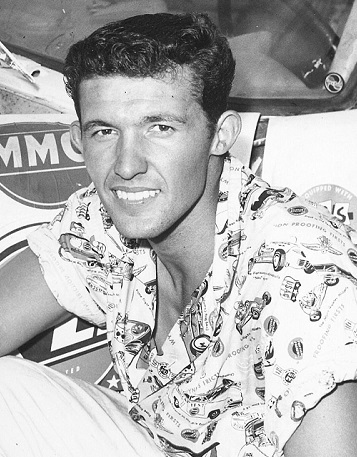
a former NASCAR driver who raced in the Strictly Stock/Grand National Era and the NASCAR Winston Cup Series. "The King", as he is nicknamed, is most well known for winning the NASCAR Championship seven times (Dale Earnhardt and Jimmie Johnson are the only other drivers to accomplish this feat), winning a record 200 races during his career, winning the Daytona 500 a record seven times, and winning a record 27 races (ten of them consecutively) in the 1967 season alone. He also collected a record number of poles (127) and over 700 top-ten finishes in his 1,185 starts, including 513 consecutive starts from 1971–1989. Petty is a member of the inaugural class of the NASCAR Hall of Fame. He was inducted into the Hall in 2010. Petty is a second generation driver. His father, Lee Petty, won the first Daytona 500 in 1959 and was also a 3 time NASCAR champion. Richard's son, Kyle Petty, is also a well-known NASCAR driver. Richard's grandson, Adam Petty, was killed in an accident at New Hampshire International Speedway on May 12, 2000, five weeks after the death of Lee. Meanwhile, Adam's brother Austin works on day-to-day operations of the Victory Junction Gang Camp, a Hole in the Wall Gang camp established by the Petty's after Adam's death. Petty married his wife Lynda in 1958. The family still resides in Petty's home town of Level Cross, North Carolina and operates Richard Petty Motorsports. The Richard
Petty Museum is in nearby Randleman, North Carolina. Throughout Petty's career, but especially during his prime, Petty was known to stand for hours – backed against a fence, signing autographs to everyone who asked. He began his NASCAR career on July 19, 1958, 16 days after his 21st birthday. His first race was at War Memorial Stadium in Buffalo, New York. In 1959, Richard was named NASCAR Rookie of the Year, after he produced 9 top 10 finishes, including six Top 5 finishes. 1959 was also when the famous "Petty Blue" was introduced. When asked directly about the "Petty Blue" color, Richard related, years later, that indeed, it had been a fluke. Late in the 1959 season, after having to rebuild one of the '59 Plymouth Fury's, Maurice told Richard that they didn't have enough white paint for the painting of the entire car. Being brought up to waste nothing, Richard found some dark blue paint, but not in a sufficient amount to paint the
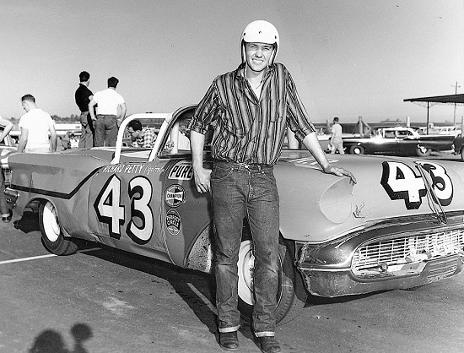
1959 Convertible Series
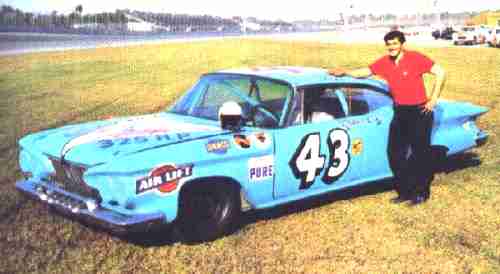
1961 Daytona 500
whole car. Richard said they he looked at Maurice, and Maurice looked at him, and they just dumped the two paints into one tub, then proceeded to paint the Plymouth in the color that came out. When they got done, they were impressed themselves with the hue. Lee came back from an out of town race, and marveled at how that color set the car off. Almost electric is what he said. Of course, Richard and Maurice had to scramble to remember the right mix. Once they did, the formula became their secret, even to the point of being patented by a paint company as Petty Blue. When the 1960 season dawned, their was only one color on the Petty cars. The "electric" Petty Blue. It became their trademark. In 1960, he finished 2nd in the
NASCAR Grand National Points Race. 1963 was his breakout year, winning at tracks like Martinsville and Bridgehampton. In 1964, driving a potent Plymouth with a new Hemi engine, Richard Petty won his first Daytona 500 leading 184 of the 200 laps, en route to 9 victories, earning over $114,000 and his first Grand National championship. Joining in the Chrysler boycott of NASCAR due to the organizing body's ban of the Hemi engine, Richard Petty and Petty Enterprises went drag racing. In a
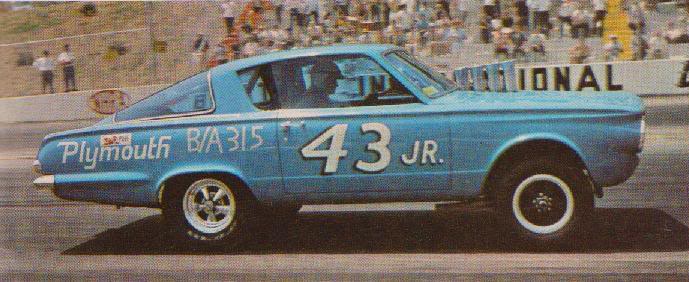
1965 Drag Racing

1970 Darlington crash
Barracuda that they called "Outlawed," Petty attracted large crowds wherever his raced. The name "Outlawed" came from when NASCAR outlawed the 426 Hemi from competition. Richard said "If you can't beat them then Outlaw them". Unfortunately, on 28 February 1965, the same day that a 100-miler was being run at the Asheville-Weaverville Speedway in Weaverville, North Carolina, Petty and "Outlawed" were at Southeastern Dragway, in Dallas, Georgia, on February 28, 1965. During a match race with Arnie Beswick, the Barracuda experienced transmission problems off the line. As Petty tried to find second gear, the car started to get loose. When Petty finally got it into second gear the car suddenly broke loose, turned towards
the spectator area, and hit the embankment. The Petty Blue Barracuda vaulted the embankment, being launched almost straight up, which carried the car over the fence that was supposed to protect the spectators, and into the crowd. Seven people were injured when the Barracuda slammed into the people who had come to watch the match races. One of these suffered severe head injuries, but there was an eighth victim, Wayne Dye - an eight-year old from Austell, Georgia. He died of his injuries before he reached the hospital. Petty suffered light injuries in the violent crash, but the shock of the young boy's death stayed with him for years. The car was hauled home to the Petty junk yard in the woods behind the shops never to run again. Petty, his father Lee, and Chrysler Corporation faced lawsuits totaling more than $1 million. On February 27,
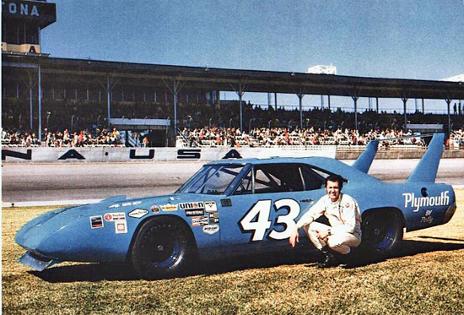
1970 Plymouth Superbird
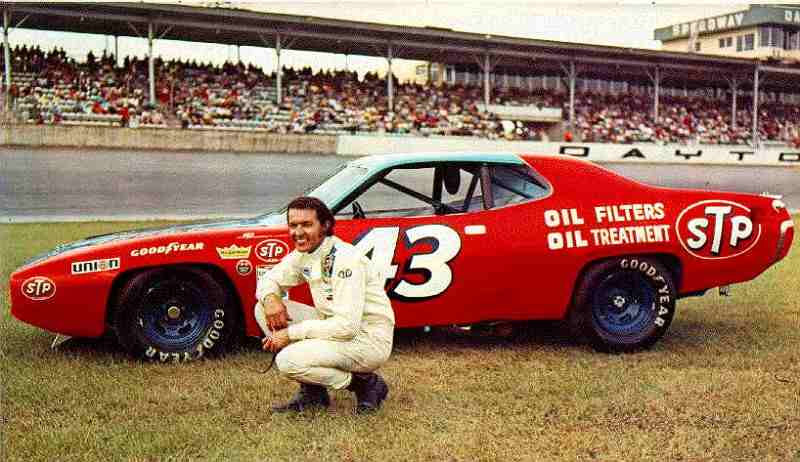
1972 Daytona 500
1966 Petty overcame a 2-lap deficit to win his second Daytona 500 when the race was stopped on lap 198 of 200 because of a thunderstorm. This made him the first driver to win the event twice. 1967 was a milestone year. In that year, Petty won 27 of the 48 races he entered, including a record 10 wins in a row (between August 12 and October 1, 1967). He won his second Grand National Championship. One of the 27 victories was the Southern 500 at Darlington, which would be his only Southern 500 victory. His dominance in this season earned him the nickname "King Richard". He had previously been known as "the Randleman Rocket". In 1969 Petty switched brands to Ford, due to his belief the Plymouth was not competitive
on super-speedways; he wanted a slippery Dodge Daytona but Chrysler executives insisted he stay with Plymouth. He would win 10 races and finish second in points. In 1970 he switched back to the sleek newly designed Plymouth Superbird (video) with shark nose and goalpost wing. On February 14, 1971, Petty won his third Daytona 500, driving a brand-new (for 1971) Plymouth Road Runner and beating team mate, Buddy Baker, by little more than a car length en route to another historic year, making him the first driver to win the event three times. He won 20 more races, became the first driver to earn more than $1 million in career earnings, and claimed his third Grand National Cup Championship. At the end of the 1971 season Chrysler told the Pettys they would no longer receive direct factory funding support, causing the Petty team great

1976 Daytona 500 last lap crash
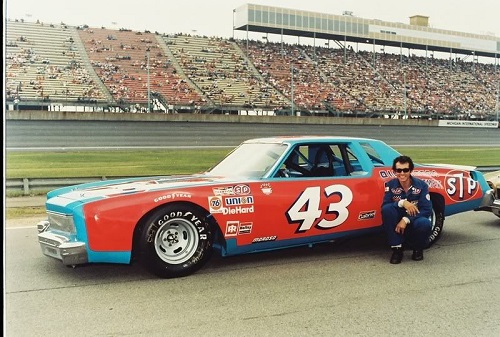
1980 Michigan
concern. In 1972, STP (motor oil company) began what would turn into a successful 28 year sponsorship arrangement with Petty, however it marked the end of Petty's famous all "Petty Blue" paint job. STP at first insisted on an all STP orangish-red color for the cars, but Petty balked, and after an all-night negotiation session the familiar STP orange/Petty blue paint scheme was agreed to as a compromise that would find its way to all STP racing operations, most notably Gordon Johncock's 1982 Indianapolis 500 winner. In 1973 Petty would go on to win his fourth Daytona 500 after Buddy Baker's engine gave out with six laps left. One year later, Petty won the Daytona "450" (shortened 20 laps {50 miles} due to the energy crisis) for the fifth time en route to his fifth Winston Cup Championship. The year 1975 was another historic
year for Petty, as he won the World 600 for the first time in his career, one of 13 victories en route to his sixth Winston Cup. The 13 victories is a modern (1972 to present) NASCAR record for victories in a season, and was tied in 1998 by Jeff Gordon, although Gordon won 13 out of 33 races, compared to Petty's 13 out of 30 races. In 1976, Petty was involved in one of the most famous finishes in NASCAR history. Petty and David Pearson were racing on the last lap out of turn 4 in the Daytona 500. As Petty tried to pass Pearson, at the exit of turn 4, Petty's right rear bumper hit Pearson's left front bumper. Pearson and Petty both spun and hit the front stretch wall. Petty's car came to rest just yards from the finish line, but his engine stalled. Pearson's car had hit the front stretch wall and
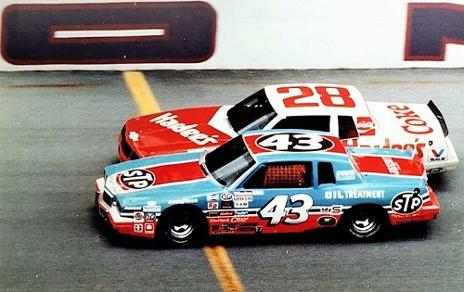
1984 Daytona 200th win
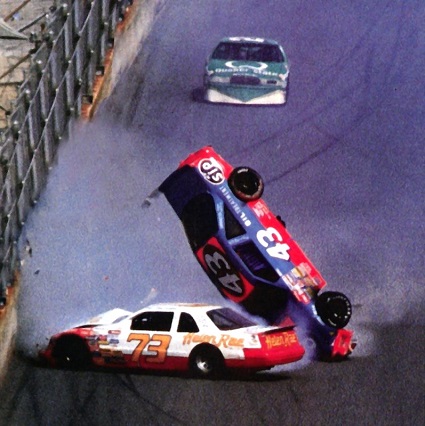
1988 Daytona wreck
clipped another car, but his engine was running. Pearson was able to drive his car toward the finish line, while Petty's car would not restart. Pearson passed Petty on the infield grass and won the Daytona 500. Petty was given credit for second place. Petty won two more Daytona 500's in 1979 and 1981. In 1979, he snapped a 45-race drought, winning his sixth Daytona 500, the first to be televised live flag-to-flag; it would become notorious for a fistfight between competitors following the controversial finish. Petty won the race as the first and second place cars of Donnie Allison and Cale Yarborough crashed on the last lap. Petty held off Darrell Waltrip and A.J. Foyt. The race is also regarded as being the genesis of the current surge in NASCAR's popularity. The East Coast was snowed in by a blizzard, giving CBS a captive audience. The win was part of Richard's seventh and last NASCAR Cup Championship. Petty was able to hold off Waltrip to win the title in 1979. In the 1981 Daytona 500, Petty used a "fuel only" for his last pit stop, with 25 laps to go, to outfox Bobby Allison and grab his seventh and final Daytona 500 win. In 1983, he broke his 43 race win-less streak from 1982 with a win in the 1983 Carolina 500, barely edging out a young Bill
Elliott. After a controversial win at Charlotte in October 1983 (win No. 198), in which Petty's brother Maurice, who built the team's engines, was accused of running an illegal engine (it was much larger than the allowed 358 cubic engines, NASCAR officials determined in a post-race inspection), Petty left the race team his father founded for the 1984 season. He spent '84 and '85 driving for Mike Curb before returning to Petty Enterprises in 1986. On July 4, 1984, Petty won his 200th (and what would turn to be his final victory) race at the Fire Cracker 400 at Daytona International Speedway. The race was memorable: On lap 158, Doug Heveron crashed, bringing out the yellow caution flag, essentially turning lap 158 into the last lap as the two drivers battled back to the start-finish line. Petty and Cale Yarborough diced it out on that lap, with
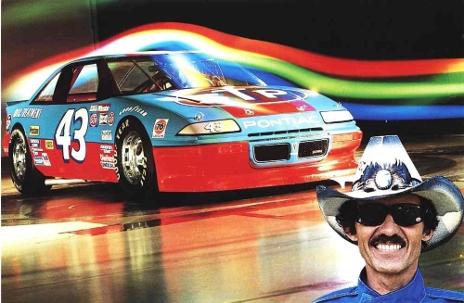
1990 Cup ride
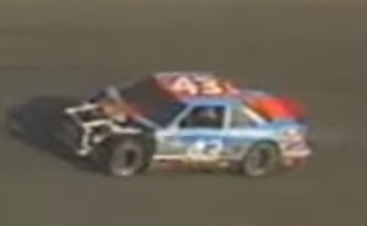
Final Career Cup Lap - Atlanta 1992
Yarborough drafting and taking an early lead before Petty managed to cross the start/finish line only a fender-length ahead. President Ronald Reagan was in attendance, the first sitting president to attend a NASCAR race. Reagan celebrated the milestone with Petty and his family in victory lane. On October 1, 1991, Richard Petty announced he would retire after the 1992 season. Petty's final top ten finish came at the 1991 Budweiser at the Glen which was the same race J. D. McDuffie was killed in a fifth lap accident. Petty chose to run the entire 1992 season, not just selected events as other drivers have done before retirement. His year-long Fan Appreciation Tour took him around the country, participating in special events, awards ceremonies, and fan-related meetings. In
his final year behind the wheel, he had two notable races. At the 1992 Pepsi 400 on July 4, Petty qualified second. Before the start of the race, he was honored with a gift ceremony which included a visit from President George H. W. Bush. At the start, Petty led the first five laps, but dropped out on lap 84 due to fatigue. Despite the tremendously busy appearance schedule, and mediocre race results, Petty managed to qualify for all 29 races in 1992. On his final visit to each track, Petty would lead the field on the pace lap to salute the fans. Petty's final race was the season-ending Hooter's 500 at Atlanta Motor Speedway. The race was notable in that it was the first career start for Jeff Gordon, and it was the 2nd closest points championship in NASCAR history, with six drivers mathematically eligible to win the championship. A record
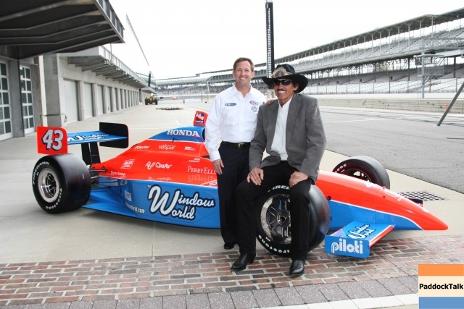
2009 Indy 500 with driver John Andretti
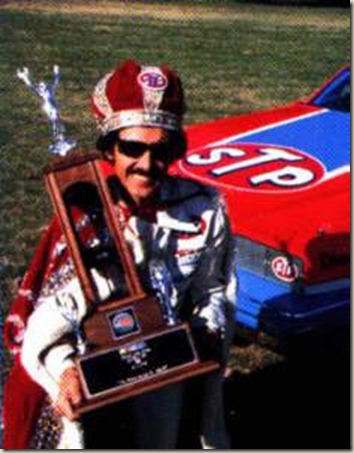
160,000 spectators attended the race, which went down to the final lap with Bill Elliott winning the race, and Alan Kulwicki winning the championship by 10 points over Elliott; after Davey Allison dropped out early after a crash. On the 94th lap, Petty became tangled up in an accident, and his car caught fire. Petty pulled the car off the track, and climbed out of the burning machine uninjured. His pit crew worked diligently and with less than 20 laps to go got the car running again, and with two laps to go, Petty pulled out of the pits and was credited as running at the finish in his final race. As you can see in the picture above the car was badly damaged in the crash and the crew did an amazing job just to get the car back onto the track. He took his final checkered flag finishing in 35th position. After the race, Petty circled the track (video) to salute the fans one final time in his trademark STP Pontiac. Of all the races he won, Petty is also remembered for three of the many incredible crashes that he survived. In the 1970 Rebel 400 at Darlington, Petty was injured when his Plymouth Road Runner cut a tire and slammed hard into the wall separating the track from the pit area. The car flipped several times before coming to rest on its side. This accident injured Petty's shoulder, and helped Bobby Isaac to win the 1970 Grand National Championship. During the accident, Petty's head hit the track pavement several times, which led NASCAR to mandate the installation of the Petty-
developed safety net that covers the driver's side window. In a 1980 race at Pocono, Richard slammed the Turn 2 wall, nearly flipping the car. Petty barely escaped breaking his neck in the wreck and kept his injury hidden from NASCAR officials for the next races, knowing that another wreck could possibility kill him. Such an incident could never happen today, because of modern NASCAR rules requiring an official series medical liaison to clear a driver after a crash. In the 1988 Daytona 500, Petty's crash on Lap 106 hurled parts all over the front stretch at the Daytona International Speedway. After several flips, Petty walked away with no serious injuries, except for temporary sight loss due to excessive g-forces. After Petty retired from driving one of the drivers he hired to wheel the #43
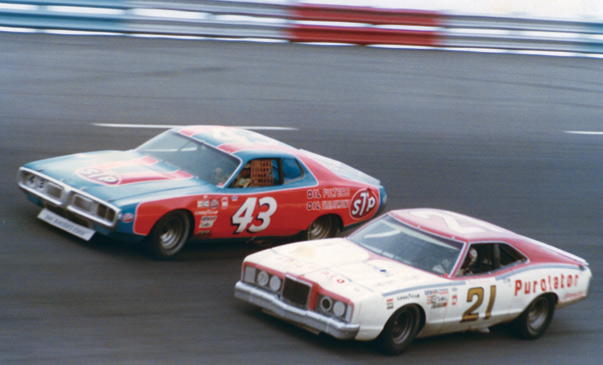
We saw a lot of Petty Pearson battles over the years
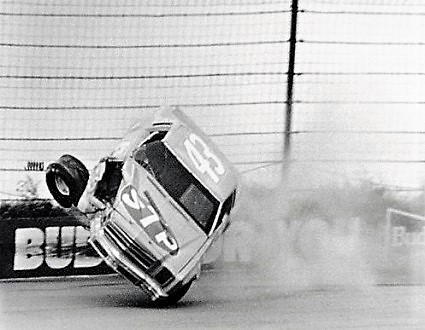
Pocono crash 1980
was John Andretti, Andretti drove for Petty Enterprises in 1994 and from 1998 - 2003. He was able to garner a win at Martinsville in 1999. Due to their past relationship, Petty sponsored a car for Andretti to drive in the Indy 500 from 2009 - 2011. For his career Petty ran 1184 Cup events and collected 200 Cup wins. He also had 555 top five finishes. He also ran 15 races in the Convertible and won one event (Columbia SC in 1959). Among his awards he was voted into the initial class of NASCAR's Hall of Fame, he was also inducted into the International Motorsports Hall of Fame, Motorsports Hall of Fame of America and was named one of NASCAR's 50 Greatest Drivers. He was awarded the Medal of Freedom by President George Bush in 1992, the first motor sports athlete ever to be honored with this award. Some info from Wikipedia
All Photos copyright and are property of their respective owners
